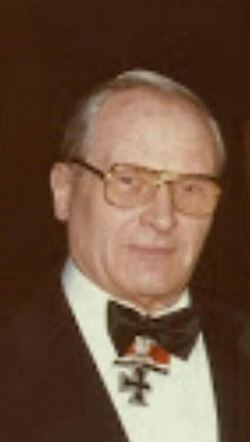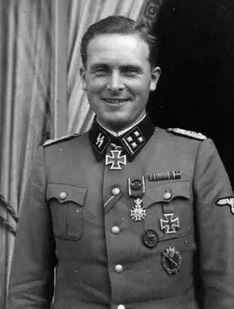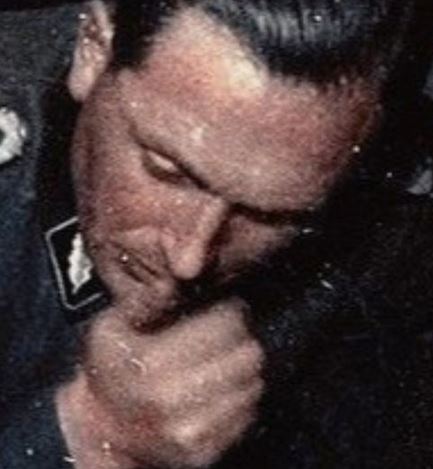Wisch, Theodor Peter Johann "Teddi" (Waffen SS)
- Date of birth:
- December 13th, 1907 (Wesselburenerkoog/Holstein, Germany)
- Date of death:
- January 11th, 1995 (Norderstedt/Schleswig-Holstein, Germany)
- Service number:
- SS-Nr.: 4.759 // NSDAP-Nr.: 369.050
- Nationality:
- German
Biography
Promotions:
02.11.1930: SS-Anwärter
20.01.1931: SS-Mann
01.03.1931: SS-Scharführer
08.01.1932: SS-Truppführer
28.07.1933: SS-Sturmführer
01.10.1933: SS-Sturmhauptführer
30.01.1940: SS-Sturmbannführer
27.09.1941: SS-Obersturmbannführer der Waffen-SS
30.01.1943: SS-Standartenführer der Waffen-SS
01.07.1943: SS-Oberführer der Waffen-SS
30.01.1944: SS-Brigadeführer und Generalmajor der Waffen-SS
Career:
01.11.1930: joined the NSDAP
02.11.1930: joined the SS
00.00.1930-17.03.1933: 1.Sturm / 53. SS-Standarte (Wesselburen)
17.03.1933: assigned to SS-Sonderkommando Berlin - renamed "Leibstandarte Adolf Hitler"
01.09.1939: Chef 1. Sturm / "LSSAH"
01.07.1941-15.07.1942: Kdr. II. Bataillon / SS-Infanterie-Regiment "LAH"
15.07.1942-03.07.1943: Kdr. Inf.-Rgt. (mot.) 2 "LSSAH"
16.03.1943: renamed Pz.Gren.Rgt. 2 "LSSAH"
04.07.1943-20.08.1944: Kdr. SS-Panzergrenadier-Division "Leibstandarte SS Adolf Hitler"
22.10.1943: renamed 1. SS-Panzer-Division "Leibstandarte SS Adolf Hitler"
20.08.1944: severely WIA
21.08.1944-08.05.1945: lengthy hospitalization in the SS-Lazarett in Hohenlychen and amputated of both legs then assigned to SS-Führungshauptamt being declared unfit for further frontline duty
Do you have more information about this person? Inform us!
- Period:
- Second World War (1939-1945)
- Rank:
- SS-Hauptsturmführer (Captain)
- Unit:
- Kompanie-Chef, 1. Sturm, I. Sturmbann, Leibstandarte SS “Adolf Hitler”
- Awarded on:
- September 24th, 1939
- Period:
- Second World War (1939-1945)
- Rank:
- SS-Hauptsturmführer (Captain)
- Unit:
- Kompanie-Chef, 1. Sturm, I.Sturmbann, Leibstandarte SS “Adolf Hitler”
- Awarded on:
- November 8th, 1939
- Period:
- Second World War (1939-1945)
- Rank:
- SS-Sturmbannführer (Major)
- Awarded on:
- November 5th, 1940
- Period:
- Second World War (1939-1945)
- Rank:
- SS-Sturmbannführer (Major)
- Awarded on:
- July 28th, 1941
- Period:
- Second World War (1939-1945)
- Rank:
- SS-Sturmbannführer (Major)
- Unit:
- Kommandeur, II. Bataillon, SS-Panzer-Grenadier-Regiment "Leibstandarte SS Adolf Hitler”, Panzergruppe 1, Heeresgruppe Süd
- Awarded on:
- September 15th, 1941
506th Award.
- Period:
- Second World War (1939-1945)
- Rank:
- SS-Obersturmbannführer (Lieutenant-colonel)
- Awarded on:
- March 2nd, 1942
- Period:
- Second World War (1939-1945)
- Rank:
- SS-Obersturmbannführer (Lieutenant-colonel)
- Awarded on:
- September 3rd, 1942
Received with swords.
- Period:
- Second World War (1939-1945)
- Rank:
- SS-Obersturmbannführer (Lieutenant-colonel)
- Awarded on:
- September 4th, 1942
- Period:
- Second World War (1939-1945)
- Rank:
- SS-Standartenführer (Colonel)
- Unit:
- Kommandeur, SS-Panzergrenadier-Regiment 2, "Leibstandarte SS Adolf Hitler”
- Awarded on:
- February 25th, 1943
Award 3/611.
- Period:
- Second World War (1939-1945)
- Rank:
- SS-Oberführer (Brigade General)
- Unit:
- 1. SS-Panzer-Division, "Leibstandarte SS Adolf Hitler"
- Awarded on:
- December 31st, 1943
- Period:
- Second World War (1939-1945)
- Rank:
- SS-Brigadeführer / Generalmajor der Waffen-SS (Brigadier)
- Unit:
- Kommandeur, 1. SS-Panzer-Division, "Leibstandarte SS Adolf Hitler", 1. SS-Panzerkorps, Heeresgruppe Süd
- Awarded on:
- February 12th, 1944
"SS-Brigadeführer Wisch was awarded the Knight's Cross to the Iron Cross on the 16.09.1941 for his outstanding achievements along the road west of Zhitomir during the defensive battles in the time period 11.-17.07.1941. Here his Bataillon was able to repeatedly halt the round-the-clock onslaught of the Russian masses due to a combination of the troops' bravery as well as the commander's personal intervention at the hotspots of the defensive battle on a daily basis.
I. SS-Brigadeführer Wisch would continue to display high qualities of leadership and personal bravery throughout the remainder of the 1941 eastern campaign, particularly during the clearing of the Nogai Steppe in September 1941, the capture of Mariupol and the defensive fighting in and west of Rostov. Although his Bataillon was frequently deployed far from the remainder of the Division (and thus effectively operating alone), he was nonetheless able to carry out his missions in a commendable fashion, being particularly consistent with personal reconnaissance in the foremost line in particular. Throughout this time he acted with confidence and a clear instinct for the weaknesses of the enemy, with the outcome being an accumulation of great successes on the tactical level that resulted in heavy losses for the enemy in both men and materiel.
II. SS-Brigadeführer Wisch once again proved himself to be a foremost leader and fighter for his men whilst serving as commander of SS-Pz.Gren.Rgt. 2 'LSSAH' during the winter campaign of February/March 1943.
He and his troops first successfully intercepted all attacks by the Russian masses whilst defending their thinly occupied security line east of Kharkov and during the ordered withdrawal thereafter. In this time he succeeded in relieving the 298. and 320. Infanterie-Divisionen after they had fought their way back through enemy territory, and furiously conducted counterthrusts launched by his III. (gep.) Bataillon were able to inflict bloody losses on the enemy forces.
SS-Brigadeführer Wisch personally led his troops forwards as our own counterattack commenced on the 02.03.1943. He and his foremost Kompanien (in particular his armoured Bataillon) were able to storm past Ljachowa Farm and seize a bridgehead at Bridok following fierce offensive combat. This laid the groundwork for the later capture of Walki. In the following days SS-Brigadeführer Wisch personally oversaw the capture of Ogulzy and Ljubotin, which would both later serve as a springboard for the attack against Kharkov.
During the fighting around Kharkov (in which his Regiment was deployed along the open right flank) he managed to force a path into the railway facilities on the very first day of the attack (the 10.03.1943). From here he and his men eliminated a major flank threat from the commanding and heavily wooded southern part of Kharkov before eventually seizing the city centre, with the eastern edge of Kharkov also being reached after another 2 days of combat.
The swift capture of Belgorod in March 1943 commenced with furious attacks launched by his Regiment (which he once again led personally). After breaching the first major enemy resistance with a wide-ranging pursuit operation the city itself eventually fell into our hands, largely thanks to SS-Brigadeführer Wisch's timely employment of his III. Bataillon for this express purpose in an ideal fashion.
III. The high military qualities and great energy of SS-Brigadeführer Wisch continued to be exhibited while he served as commander of the 1. SS-Pz.Gren.Div. 'LSSAH' during Operation Citadel. Throughout this entire period he led from the foremost line in the grinding offensive and defensive combat. The successes in the offensive phase are attributable to his personal intervention. Throughout these days of battle his SPW could always be found either in the midst of friendly attacks or rushing from one command post to another across the battlefield. His ability to accurately assess the situation and his continual presence in the foremost line were key factors that enabled the operational defense of SS-Pz.Rgt. 1 and the Sturmgeschütz-Abteilung to defeat the surprise attack by two tank corps that the enemy launched on the 12.07.1943. On this day 130 enemy tanks were destroyed in a 2 hour period due to the combined efforts of friendly Panzers, Sturmgeschütze and close combat troops.
IV. After completing the disarming of those troops in the entire upper Italian plain, SS-Brigadeführer Wisch and his Division found themselves in intense combat in the area around Zhitomir, Korosten, Berdichev and southwest of Pogrbischtsche from the 01.11.1943 onwards. SS-Brigadeführer Wisch would be the soul of the fight in all of the fighting that has taken place in this area up until the present day, which encompasses 5 major friendly offensive operations as well as defensive combat in the area east of Zhitomir/Berdichev and southwest of Berdichev.
1) During the Division's thrust into the enemy's deep flank within the time period 14.-18.11.1943 (via Kornin, Ssolowjewka and the Zhitomir-Kiev road at Kotscherowo), hostile forces interdicted the main route of advance following the breakthrough by the divisional armoured group. They established themselves around Ssolowjewka (with the bulk being in Brusilov) and tried to prevent the Division's advance via counterattacks of their own. However aggressive flank protection missions conducted by elements of 2. Regiment as well as the Aufklärungs-Abteilung enabled the Division to secure the newly-won ground towards the east.
During an opposing breakthrough towards the west on the 16.11.1943 SS-Brigadeführer Wisch (who had himself just returned from a reconnaissance sortie) deployed a response force consisting of several Sturmgeschütze and elements of the III.(gep.)/2. Regiment. Under his inspiring command it launched a counterattack that annihilated a battalion-sized enemy group, thereby preventing the Soviets from reaching the road as per their intentions.
2) After this breakthrough to the highway the Division received the mission of destroying several strong infantry battlegroups that had infiltrated through the forested terrain east of Radomyschl.
Instead of waiting for the assembly of the Division (delayed by the bad road conditions), SS-Brigadeführer Wisch dispatched all operational Sturmgeschütze with mounted infantry support. With this force (as well as another SPW equipped Kampfgruppe deployed further to the northeast) it was possible to quickly gain ground. Within a few days these two Kampfgruppen had united in the rear of the enemy, and in conjunction with a frontal onslaught by the remaining divisional elements it was possible to form an encirclement and crush the enemy.
3) Starting on the 05.12.1943 the Division fought in the area east of Tschernjachoff. Its mission was to restore contact between XIII. and LIX. Armee-Korps in the sector east of Korosten by throwing back and destroying strong enemy battlegroups that had emerged from the vicinity of Radomischl.
SS-Brigadeführer Wisch began this operation by launching a deep thrust with a powerful armoured group that made it to a point 30 km behind the lines of those enemy forces arrayed before XIII. Armee-Korps. Disregarding the XIII. Armee-Korps' subsequent combat to destroy the enemy elements in the rear and flank of his Division, SS-Brigadeführer Wisch instead deployed the armoured group in another equally bold strike that smashed the enemy's operational bridgehead at Radomischl.
The supreme commander of 4. Panzer-Armee, General Raus, personally expressed his particular appreciation for the success of this operation whilst he was present at the divisional command post. Such a victory is attributable to the bravery and superhuman efforts (both in body and spirit) displayed by the Panzer crews and Grenadiers, but also (and in no small part) to SS-Brigadeführer Wisch himself. He was present and active in the foremost line with his SPW on every day of the operation.
4) On the 20.12.1943 the Division received a new mission. Along with the 1. and 7. Panzer-Divisionen, it was to strike eastward from the area east of Korosten in order to throw back and eliminate the enemy.
After the enemy had been ejected from their field positions following bitter combat, the Division's attack spearheads deviated from their original axes of attack whilst pushing through the dense swampy and bush terrain that lay ahead. Before the confusion got any worse, SS-Brigadeführer Wisch personally took over command of his lead Grenadiers and Panzers with compass in hand.
In this partisan territory, communication with the leadership of the various Kampfgruppen from the divisional command post was next to impossible due to the chronically poor radio contact. As such SS-Brigadeführer Wisch remained with his foremost elements by both day and night as they pressed forward.
SS-Brigadeführer Wisch subsequently demonstrated both great bravery and excellent leadership qualities during the defensive battles against the bulk of the Third Guards Tank Army. Although his Division's armoured strength was fairly low following the long road march from the Korosten region to the area east of Zhitomir, SS-Brigadeführer Wisch was able to swiftly coordinate his Panzers to where they were needed most in the fighting. As such the massive onslaught by the hostile armour was significantly disrupted by his own troops, and by creating Pakfronts from battle-damaged Panzers it was possible to split up the enemy's tank forces.
This harsh combat in the area east and southwest of Berdichev was recognized in both the Division's mention in the Wehrmachtbericht of the 31.12.1943 as well as in a personal telegram from Generalfeldmarschall von Manstein from the 15.01.1944.
V. Under SS-Brigadeführer Wisch's command the 1. SS-Panzer-Division 'LSSAH' destroyed/captured the following during the operations in the time periods 05.-12.07.1943 and 06.11.1943-31.01.1944:
1124 T-34 tanks
12 KV tanks
6 Lend-lease tanks
5 armoured cars
89 assorted tanks (small variants)
6 artillery pieces (7.62 cm short)
34 artillery pieces (12.2 cm)
5 AA guns
7 Katyushas
97 assorted artillery pieces
227 medium anti-tank guns (3.7-4.5 cm)
1056 heavy anti-tank guns (7.62 cm)
12 mortars (50 mm)
45 mortars (82 mm)
73 mortars (122 mm)
553 anti-tank rifles
638 machine-guns
575 machine-pistols
2003 rifles
9 emplaced flamethrowers
37 aircraft
334 vehicles
98 horse-drawn wagons
2953 prisoners
16541 dead
I believe SS-Brigadeführer Wisch to be worthy of receiving the Oakleaves to the Knight's Cross of the Iron Cross on account of his consistently demonstrated bravery, his achievements on the battlefield and the outstanding leadership of his Division. I would like to request that he receive this high honour."
393rd Award.
- Period:
- Second World War (1939-1945)
- Rank:
- SS-Brigadeführer / Generalmajor der Waffen-SS (Brigadier)
- Unit:
- Kommandeur, 1. SS-Panzer-Division, "Leibstandarte SS Adolf Hitler", 1. SS-Panzerkorps, Heeresgruppe Süd
- Awarded on:
- August 30th, 1944
"I am recommending the Oakleaves with Swords for SS-Brigadeführer Wisch, commander of the 1. SS-Pz.Div. Leibstandarte Adolf Hitler.
Wisch and his Division performed outstandingly in the fighting between Caen and Falaise. In this time Wisch succeeded in halting all enemy breakthrough attempts in a tireless display of duty. He eliminated a major penetration in the sector of the left neighbouring unit via a boldly led counterattack that was launched on his own initiative. The Division also held its ground against the fiercest of enemy attacks during the combat in the encirclement at Falaise, a period in which the commander conducted multiple counterthrusts.
On the day of the breakout Wisch personally led his infantry in the breakthrough. Although the men were engulfed in a hitherto unseen display of firepower in the narrow area available for maneuver they were inspired forwards by their commander's example. Wisch was himself badly wounded whilst fighting in the foremost line.
Wisch is particularly worthy of this high award on account of his successful leadership and battlefield conduct."
94th Award.
- Period:
- Second World War (1939-1945)
- Awarded on:
- September 1944
- Period:
- Second World War (1939-1945)
- Awarded on:
- November 1944
- Period:
- Second World War (1939-1945)
- Awarded on:
- 1945
Sources
- Photo 2:
- Photo 3: https://forum.axishistory.com/viewtopic.php?f=5&t=29879&p=2297555&hilit=wisch+theodor&sid=eea9c1a13b91d96ccbf548d5058825be#p2297555
- Photo: Public Domain
- - LIPPL, MARKUS, SS-Brigadeführer und Generalmajor der Waffen-SS Theodor “Teddy” Wisch, Schiffer PUBLISHING, 2012.
- MOONEY, PETER, Waffen-SS Knights and their Battles, Schiffer Pub Ltd, 2008.
- MOONEY, PETER, Waffen-SS Knights and their Battles, Schiffer Military History, 2016.
- THOMAS, FRANZ & WEGMANN, GüNTER, Die Eichenlaubträger 1940-1945, Biblio-Verlag, 1998.
- wisch theodor 2.JPG.
- wisch theodor 2.JPG1.JPG.
- Die Ordensträger der Deutschen Wehrmacht (CD), VMD-Verlag GmbH, Osnabrück, 2002
- Kwasny A., Kwasny G., Die Eichenlaubträger 1940-1945 (CD), Deutsches Wehrkundearchiv, Lage-Waddenhausen, 2001
- Fellgiebel W.P., Elite of the Third Reich, The recipients of the Knight's Cross of the Iron Cross 1939-1945: A Reference, Helion & Company Limited, Solihull, 2003, ISBN 1-874622-46-9
- Patzwall K., Scherzer V., Das Deutsche Kreuz 1941-1945, Geschichte und Inhaber Band II, Verlag Klaus D. Patzwall, Norderstedt, 2001, ISBN 3-931533-45-X
- Federl, C., Die Ritterkreuzträger der Deutschen Panzerdivisionen 1939-1945, VDM Heinz Nickel, Zweibrücken, Germany, 2000
- Yerger, Mark C., Waffen-SS Commanders – The Army, Corps and Divisional Leaders of a Legend Krüger to Zimmermann, Shiffer Publishing Ltd., U.S.A., 1999
- Mooney, P., Dietrich’s Warriors, Shiffer Publishing Ltd., U.S.A., 2004
- Williamson, G., German Commanders of World War II (2), Osprey Publishing Ltd., Great Britain, 2006
- Butler, R., SS-Leibstandarte, MBI Publishing Company, U.S.A., 2001
- Ritterkreuztraeger-1939-45.de
- Lexikon-der-wehrmacht.de
- Axis Biographical Research
- Microfilm Publication A3343. US National Archives































